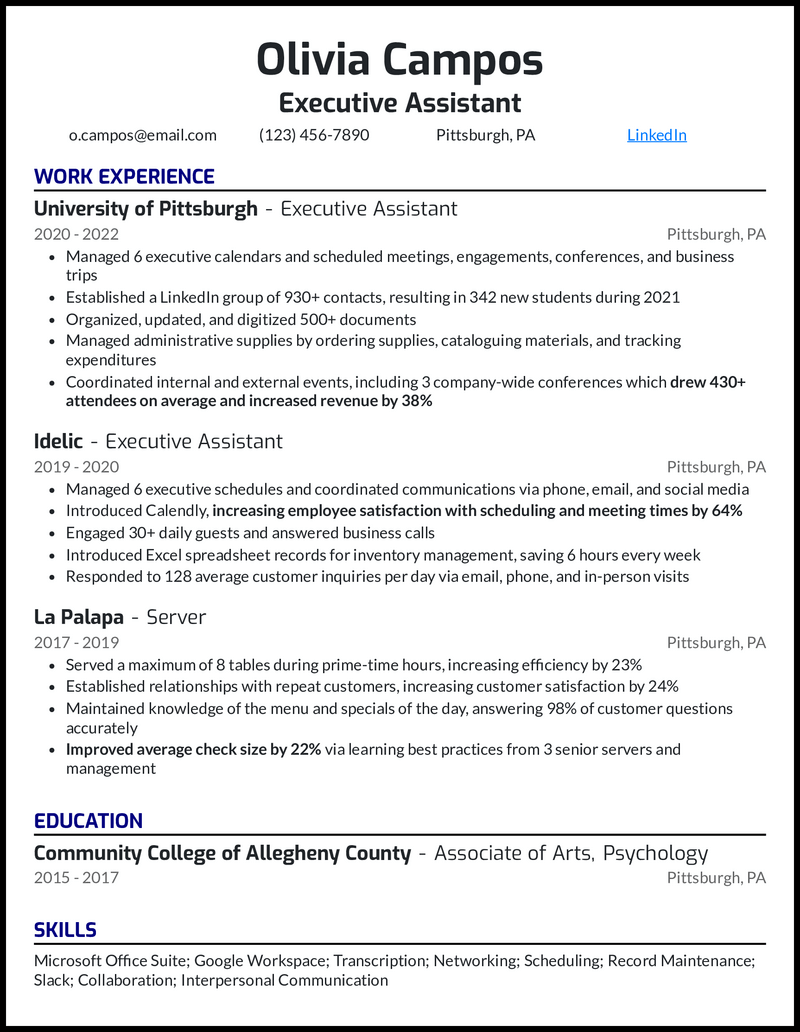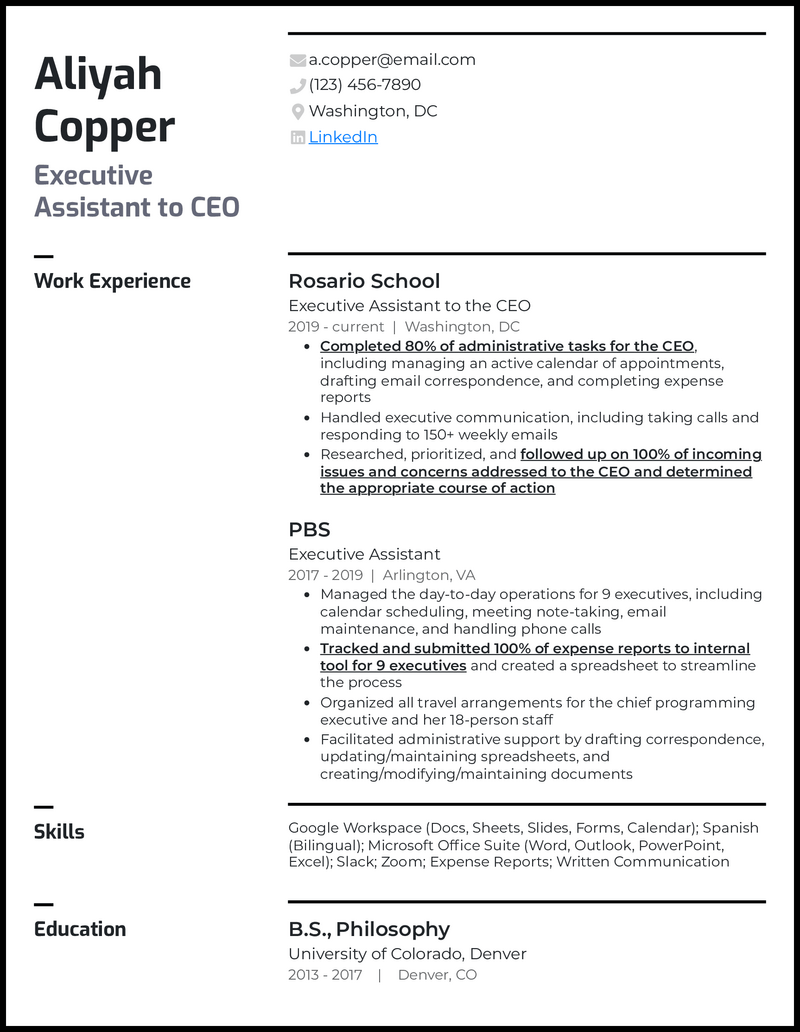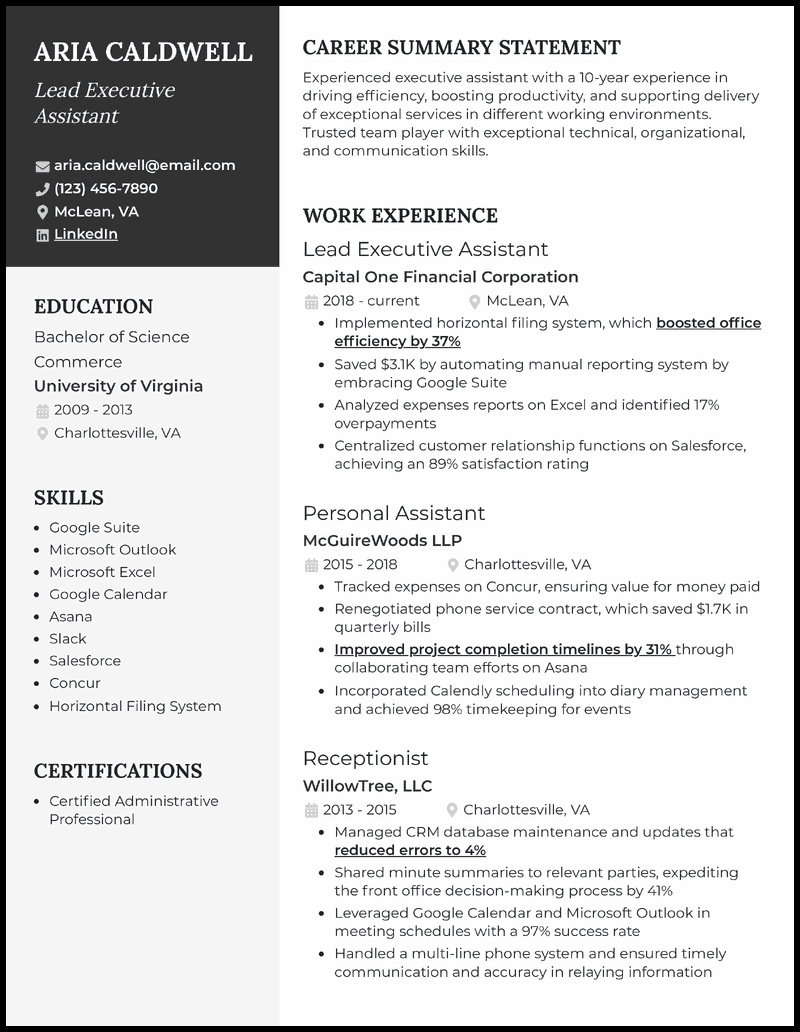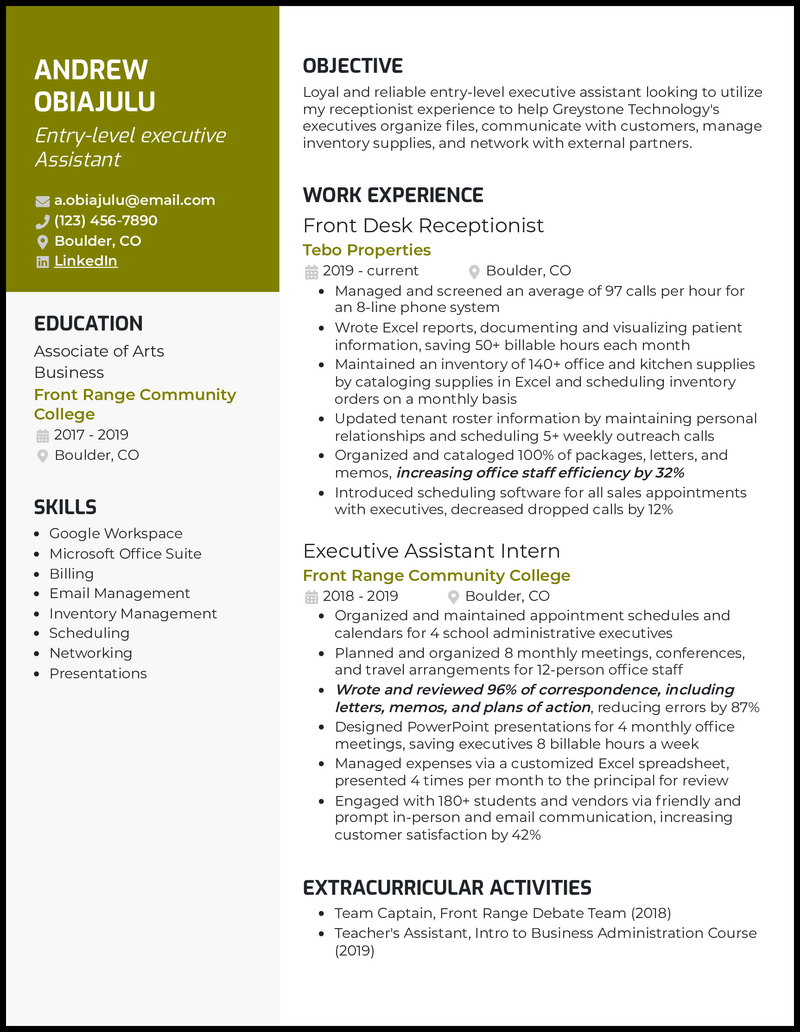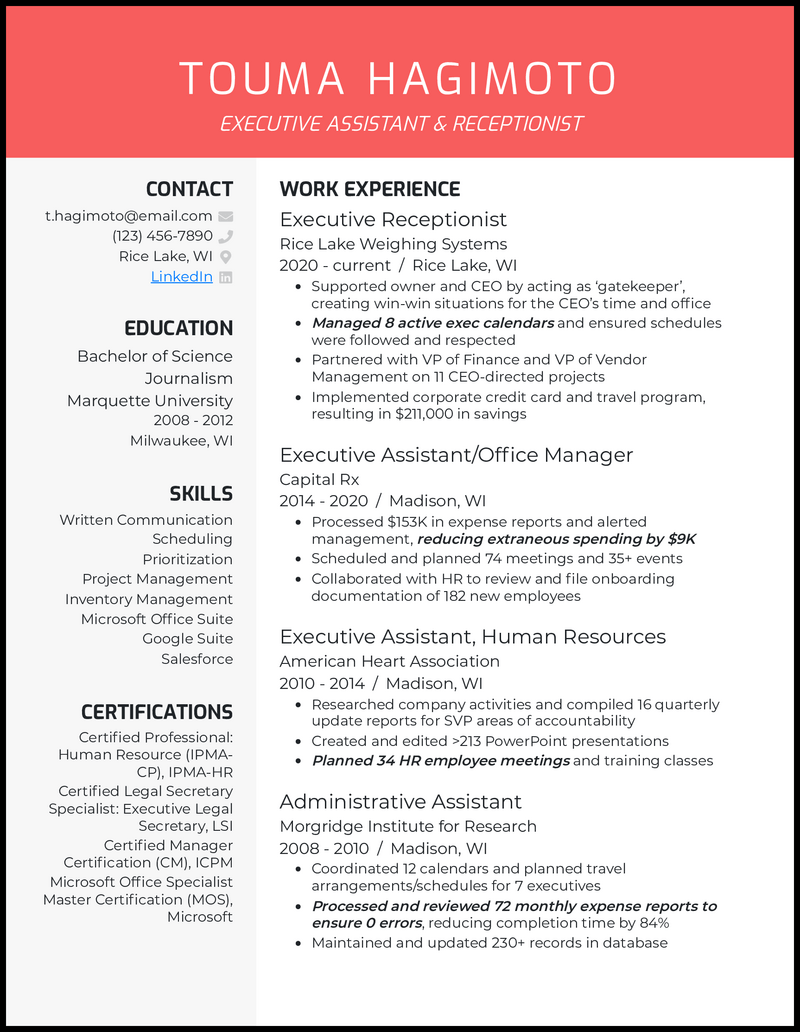You can present a lecture to a packed conference room, write error-free reports, and organize even the most cluttered inventory. And no matter how busy an executive is, you always find a way to make their schedule manageable.
Overall, you’re an incredible executive assistant. But even with your superior writing skills, building a resume and making a cover letter isn’t as easy as it sounds.
We’ve analyzed hundreds of resumes to determine what does and doesn’t get you an interview. We put all our knowledge into this guide and our 15 executive assistant resume examples that have helped people land jobs in 2026.
Use our resume samples and writing tips to avoid the dreaded blank page and get the executive assistant job you’ve always wanted!
Why this resume works
- Your responsibilities are all-encompassing, which means it’s hard for employers to know exactly what you’re capable of. Thus, it’s vital to include specific capabilities in your resume skills section on your executive assistant resume. Competencies like “Slack,” “Microsoft Office Suite,” and “Networking” showcases your communication abilities, technical skills, and entrepreneurial attitude.
Why this resume works
- It’s tricky to demonstrate exactly how your work as an executive assistant impacted the company, which means it’s hard to know what metrics to include on your executive administrative assistant resume. You can start by listing how many team members you’ve worked with, how many customers you helped, and how many schedules you managed.
Why this resume works
- If you have over 10 years of experience, you may wonder if you need to use a CV versus a resume. Both are useful in your senior executive assistant resume, but CVs are generally geared towards academia and highly technical fields. You can probably get away with simply using a resume, although you should always check the executive assistant job description to make sure.
View more senior executive assistant resumes >
Why this resume works
- When you’re an executive assistant to the CEO, the primary focus of your job is supporting the head of the company. So, if you’ve gone above and beyond to help your co-workers in previous positions, include it on your executive assistant to CEO resume. If you can show your dedication to helping others, hiring managers are sure to take notice.
View more executive assistant to CEO resumes >
Why this resume works
- Merging your stellar experience with your highly efficient executive and administration skills will get you noticed before your competitors. Ensure to include your achievements in streamlining processes, creating a conducive environment for work, and achieving positive numbers in resource and time management in your C-level executive assistant resume.
Why this resume works
- It’s crucial to leverage quantifiable achievements in your experienced executive assistant resume to grab the attention of recruiters. In your executive assistant cover letter, you can emphasize your organizational, people and resource management, and communication skills while matching them with relevant accomplishments in your resume.
Why this resume works
- Let your assistant to executive VP resume call attention to the awesome things you’ve done in similar roles. Spices up your assistant to executive VP section with a phrase like “managed executive calendars using Doodle, coordinating 199 meetings annually with 31% fewer conflicts.”
Why this resume works
- An executive assistant to the president operates a lot like a duck; while they appear composed on the surface, underneath it all, they’re paddling like mad to stay afloat. Thus, your executive assistant to the president resume needs to reflect your cool-headed attitude and professional capabilities.
View more executive assistant to the president resumes >
Why this resume works
- You are no stranger to the game of playing by the rules—one blunder, and it’s like dominoes on the production set, everything comes tumbling down. In the same spirit, make sure to dodge any goofs when updating your contact deets on your film executive assistant resume—a slip-up here might sink your chances.
Why this resume works
- In the work history section of your legal executive assistant resume, let phrases like “Streamlined billing and timekeeping using TimeSolv, reducing manual entry errors by 26 instances” and “designed a new time-tracking system using Bill4Time, bolstering billing accuracy for over 56 active client accounts” steal the show.
Why this resume works
- Helping C-level suites involves a day filled with arranging meetings, calendars, and even travel schedules. That’s exactly why you cannot miss out on adding a variety of skills to your executive assistant calendar management resume: From Microsoft Outlook, and Google Calendar, to Trello, and, Evernote.
Why this resume works
- As long as you can craft bullet points like “Redesigned the appointment scheduling process,” you’ll be able to impress a potential employer by showing that you’ve already got the practical experience to understand how an office in your real estate executive assistant resume.
Why this resume works
- Adding a hobbies and interests section on your entry-level executive assistant resume can underscore that you’re a responsible leader and capable researcher.
View more entry-level executive assistant resumes >
Why this resume works
- Whether you’re writing an executive assistant resume, a receptionist resume, or an executive assistant & receptionist resume, list relevant positions that match the job description. For example, if the employer wants someone with experience planning corporate events, you should include any positions where you’ve handled that responsibility.
Why this resume works
- Perhaps you managed and organized an average of 47 appointments and meetings per month using Microsoft Outlook. Or maybe you scheduled 200+ meetings and coordinated the creation of 100+ documents during your tenure as personal assistant. Now, make sure your executive assistant to the managing director resume shouts that success from the rooftops.
Related resume guides
How to Format an Executive Assistant Resume

When you’re writing your resume, the format you use is essential. Good formatting ensures that your executive assistant resume is complete, has a logical flow, and is easy to read. Without the right format, businesses may not give you an interview.
Let’s take a comprehensive look at what it takes to properly format your executive assistant resume:
- Reverse-chronological format, functional format, and combination/hybrid format
- Where to place name and contact information
- Be smarter than the ATS

Reverse-chronological format, functional format, and combination/hybrid format
There are three primary resume formats you can use when creating an executive assistant resume:
- Reverse-chronological format: This format emphasizes your experience and employment, which allows companies to see your career progression.
- Functional format: This format focuses on the skills that ensure you qualify for a job as an executive assistant, which also helps to mitigate issues with employment gaps.
- Combination/hybrid format: This format combines the reverse-chronological format and functional format by placing equal focus on employment history and skills.
While all three resume formats have their advantages, the reverse-chronological format is the top choice for an executive assistant resume. Along with being the most popular resume format across most industries, it’s also preferred by the majority of employers because it makes your work history easy to skim.

Where to place name and contact information
Your name and contact info should be the first pieces of information you place in your resume. Without it, you won’t be able to get either good or bad news regarding your job application!
Start by positioning your name at the top of the page in a large font size. While your choice of font is up to you on a resume template, if you’re building your resume in word processing software, use either Times New Roman, Cambria, Calibri, or Arial font. Underneath your name, include the title of the job you’re seeking in a slightly smaller font. If you choose to include color, including it in your name or job title would be appropriate.
As for your contact details, place the following details on the left or right side of the page near your name and job title:
- Your name
- Executive assistant title
- Phone number
- Location (city and state is fine)
- Possible LinkedIn profile
Your contact details should be between 10-12 pt font to be easy to read.
While the contact information you include in your executive assistant resume is pretty straightforward, you can be creative in how you include it. Here is just one sample of how you can format your header and contact information:
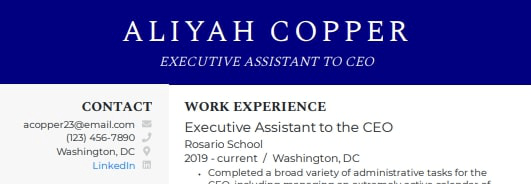

How to be smarter than the ATS
Many companies receive dozens (or even hundreds) of executive assistant applications and resumes, which means it’s practically impossible for recruiters to read every resume. Because of this, most businesses use applicant tracking system (ATS) software.
This system is designed to sort resumes by searching for keywords and scanning resume formatting. Any resume that makes it through the ATS without being discarded will then be reviewed by a recruiter. So, to get an executive assistant job, you must pass the ATS scan.
Adhere to these ATS-friendly tips when building your resume:
- Margins: Use half to one-inch margins on all sides.
- Fonts: Use standards like Times New Roman, Tahoma, Arial, Calibri, Cambria, or Garamond. Fancy fonts are hard for the ATS to read.
- Font sizes: As a rule of thumb, use 10-12 points for contact info and resume content, but increase the font size to 20-24 points for your name and job title (though the job title should be a slightly smaller font).
- Header names: Section headers should stand out, so consider using a bold font and all caps. Adding a touch of color to your section headers can help recruiters later down the line.
- Skills: Take care to customize this section according to the executive assistant job description, but make sure not to copy/paste it from the job description. (Honesty is the best policy!)
- Logical order: We recommend the reverse-chronological format because it’s easiest for the ATS to read. Thus, the bulk of your resume should be work experience, which should be listed with your most recent experience first.
- Page count: Use only one page for the entire resume, and this should be an exact page.
While you can tackle this yourself, it’s often easiest to use Word resume templates or Google Docs resume templates to help you choose content and organize your information quickly.
How to Write an executive assistant resume

Even though the idea of writing a resume for an executive assistant position might seem insurmountable, you can avoid a lot of stress by doing some simple research about what to include on a resume.
You’ve come to the perfect place to learn more about resume sections. In this section, we’ll cover:
- Objective or summary
- Job history
- Key executive assistant skills
- Education
- Projects, interests, and hobbies
- Customizing your resume
- Proofreading your resume

When do you need an objective or summary?
When writing your executive assistant resume, you candecide to add an objective or summary. These optional sections give recruiters a sense of who you are without them needing to read your entire resume. However, they may not be in your best interest, depending on your situation.
Refer to the following definitions when deciding whether you need one of these statements:
- Resume objective: A resume objective is two to three sentences that tell recruiters why you’d like to obtain the role. An objective is best used when you’re changing fields or seeking an entry-level position. Unless you’re going to specifically demonstrate your candidacy and customize it for the particular job, just leave it out.
- Resume summary: A resume summary is two to three sentences that highlight your skills and how these skills have helped you obtain quantifiable results over your career history. Summaries are used when you want to tie together years of past work experience. However, you should avoid them if you don’t have at least 10+ years of work experience (or if you don’t have the time to customize them to the job).
The following takes a look at a poorly written objective as well as a poorly written summary.
Objective: Would like to obtain a job as an executive assistant as the next step in my career.
Summary: Have extensive experience as an assistant and receptionist.
These statements are vague and fail to provide recruiters with any value. They distract from the core components of the resume and may cause an employer to discard your resume before they’ve even read it entirely.
Instead, an objective like the following would work much better:
Analytical and detail-oriented executive assistant with 5+ years of experience in helping high-level executives within Fortune 500 companies. Searching for a unique opportunity to assist the CEO of Fiori Financial Group by completing ad-hoc special projects, boosting shareholder value, and enhancing employee efficiency and procedures.
And a summary like this one is effective:
Meticulous and results-driven executive assistant with more than 15 years of administrative experience managing office operations for presidents and CEOs. From data entry, presentations, customer support, scheduling appointments, arranging itineraries, and more, I am eager to share my talent for combining administrative knowledge with business objectives to boost efficiency and conserve time at a proactive financial company like Stockd Group.
These examples provide recruiters with metrics and valuable information that they can use when trying to select the right hire. Both the sample objective and summary demonstrate specific skills and are customized to the particular role.

How to present your job history
Your work experience is the most important section of your executive assistant resume. You should include two to four job experiences pertaining to the executive assistant field.
However, if you’ve held more than four jobs, focus on the last 10 years of experience. If you have an ample amount of experience in that timeframe, include the experience that’s most relevant to the job position.
Conversely, if you’re seeking an entry-level role, you may be short on experience. In this case, consider adding projects, which we’ll discuss a bit later.

How to write job bullet points
Your job history should be written in bullet points, which allows you to focus on the most relevant information. Start by using active language instead of passive language.
For instance, “the cashier sorted the money” is an example of the active voice.
However, “the money was sorted by the cashier” is an example of passive voice.
Which is easier and more pleasant to read? Active voice conveys a clear and strong voice that works well on resumes (and in any type of writing, really).
We’d also recommend avoiding personal pronouns and ending periods. Additionally, make sure that you use the past tense for your work history. (Even if you’re currently in a position, past tense is the most accepted verb tense for resumes.)
With that information at hand, you’re ready to write your job description bullet points! Well, almost.
Above all, avoid writing bullet points that are vague and underwhelming like the ones here:
- Performed customer service 5 days each week
- Used different technology and software for documentation
- Performed demanding tasks when working for the CEO
These bullet points don’t lack quantifiable data and are too short to provide value to recruiters. Beyond that, they don’t go beyond typical job duties, and even what’s listed is awful blah. You should be detail-oriented with your work experience bullet points:
- Completed follow-ups with all contacts made by the CEO, and supported the development of ongoing relationships by making at least 30 calls every week
- Efficiently performed various accounting activities that included expense reports, invoices, financial documents, and purchase orders weekly
- Improved productivity rates by 23% between 2018 and 2020 by providing continual reports on product issues and operational concerns
These work experience bullet points are effective because they contain verifiable details as well as metrics that tell recruiters how much value you could potentially add to their company.

Add numbers to demonstrate your impact
As we’ve mentioned, it’s highly recommended that you add numbers and data to demonstrate the impact you’ve had in previous jobs. Recruiters want to know how hiring you would benefit the company, which is easy to show when you provide quantifiable information about your work experience.
These metrics could include anything from boosting revenue by a certain percentage to improving efficiency at a specific rate. The following offers a few examples of how you can place metrics into your job description bullet points:
- Performed 10-20 check requests every week as part of accounting activities
- Managed all international and domestic travel reservations, which reduced company travel expenses by 15%
- Improved office efficiency by 20% by transforming the company’s primary filing system, which also resulted in reducing paper usage by 63%

How should executive assistants describe multitasking and prioritization?
Typically, a job description outlines specific duties that the company wants you to undertake. A good example is multitasking and prioritization. Directly including how you’ve prioritized important tasks in the past is an easy way to get through the ATS system.
For example, if the listing explicitly states the company is seeking an assistant who can handle tasks without escalations, you can mention: “Resolved 91% of tasks without escalation, giving the CEO 3 extra hours each week for strategic planning.”

Key executive assistant skills to include on your resume
When resume building, the skills section of your resume is essential if you want to show recruiters why they should hire you.
Keep in mind that the ATS looks at your skills to determine if you’re a good applicant. Write between six to 10 skills in your list, and include a combination of soft skills and hard skills.
Soft skills are universal and can be placed on any resume. However, they’re more difficult to measure. Examples of soft skills include adaptability, time management, and communication.
Hard skills are more important for executive assistant resumes because they’re specific to the job, easy to define, and measurable. Some of the hard skills you might consider placing on your executive assistant resume include Zoom, Slack, Microsoft Office, Google Workspace, and expense reports.
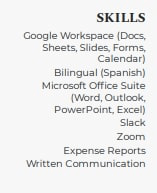
The purpose of your skills section is to quickly show the company what you offer and the technologies you know how to use. Since you shouldn’t include a laundry list of skills on your resume, search for keywords within executive assistant job descriptions. You should be able to find the exact skills recruiters are seeking.
One quick word about this, though: never lie and claim you’ve mastered a skill when you haven’t. If none of the skills in the job description sound like you, it’s probably a sign that’s not the job for you. Keep searching for other jobs that better match your skills (we know there’s something amazing out there you simply haven’t found yet).

How to list your education
An executive assistant role is one of those jobs where the education level required can really vary. Some employers may request at least an associate’s degree while others will want a bachelor’s.
Even still, some employers will be just fine with a high school diploma. While every employer has different requirements for the level of education and experience they want from potential hires, some basic pieces of information should be provided on every resume.
When it comes to listing your education, there’s no need to give an abundance of information unless you are newly graduated and need to use your education as a means to demonstrate your capabilities. Otherwise, you should just include the university name, degree, and graduation year. If you hold an associate or bachelor’s degree, you don’t need to list your high school diploma.

Should you add projects, interests, and hobbies?
Although most resumes don’t include information about projects, hobbies, or interests, there are times when you may benefit from adding this information.
If you lack lengthy work history or have just graduated from college, adding projects and interests is a great way to show that you have what it takes to be an executive assistant, even if you don’t have the work experience.
The key for adding projects or interests and hobbies is that you should be able to intelligently discuss its relevance to the executive assistant role in an interview.
For example, if you listed “backpacking in the Pacific Northwest” or “mastering woodwork” as interests and hobbies on your resume, they may seem unrelated to assisting the CEO. However, this demonstrates your ability to plan and organize your own trips and itineraries. Mastering woodwork could showcase your ability to persevere through tedious and challenging tasks, particularly new tasks.
Projects can be treated more like work experience. This could be volunteer work or even a creative project you took on for a friend or family member.
As long as it reasonably demonstrates relevancy to the executive assistant role you’re seeking, this can be an excellent way to create bullet points that prove your value when you’re lacking traditional work experience.

How to customize your executive assistant resume to each role
It’s important to customize your resume for the specific role for which you’re applying. When you send in a resume for a job as an executive assistant, the information you include shouldn’t apply to just any type of assistant or receptionist position.
Recruiters who are searching for the right hires want someone who can handle the extra demands that come with being an assistant to high-level executives and CEOs.
Luckily, you don’t have to rewrite your entire resume. Simply change keywords and some responsibilities in the objective/summary section, your work experience bullet points, and your skills section.
How to tailor an executive assistant resume for CEOs vs directors?
CEOs often require assistance with scheduling and communicating with investors and board members. Conversely, director roles may emphasize program support and cross-team coordination, so align your language depending on who you’re planning to work for.
Not sure what we mean? While applying to work with a CEO, focus on:
- Drafting investor contacts and maintaining confidential materials.
- Use language like strategic calendar design, board logistics, and investor materials.
While applying to work with a director, use:
- Phrases like cross-functional project delivery, team scheduling, and process ownership.
- Powerful impacts, such as program completion rate, stakeholder satisfaction, and status reports.

Proofreading your resume
Just when you thought you were done, there’s one last step. This specific tip is probably the easiest to follow, yet also the most overlooked.
As an executive assistant, there’s no doubt your attention-to-detail and writing abilities are top of the line; however, there’s always a possibility that you’ve made a typo, punctuation, or grammar error. These mistakes are simple to rectify as long as you check your completed executive assistant resume for errors before sending it in.
Give your eyes a break for a day or two before proofreading. Additionally, ask some friends or family members look at your executive assistant resume to gain other opinions and perspectives.

How to write an executive assistant cover letter?
A cover letter shows companies how you communicate, prioritize, and solve problems. Generally, job descriptions convey whether including a cover letter is necessary or not.
Otherwise, it’s mainly an additional document you can include to give more details on your background in helping executives. Here are some quick tips you can follow to craft a compelling cover letter:
- Address the executive’s pain points in the intro.
- Use quantified metrics from your resume.
- Keep a total of 5 paragraphs and ensure they don’t go beyond 4–5 lines.
- Include a work story that highlights your executive assistant expertise.
- Close with a strong CTA and thank you note.

Key Takeaways
- Quantify each bullet point to highlight your scheduling and coordination skills.
- Use the job description to directly mention assistant tasks the company needs.
- Choose a template that fits your SWE sections on one page.
Executive Assistant Resume FAQs

As you write an executive assistant resume, demonstrate your unmatched ability to carry out administrative tasks. To do this, you need a specific set of skills that align you with the expectations of the job posting. From your work experience, share the top achievements backed up with numbers to draw attention to your value. Adding action verbs in your bullet points and using skills to get work done will catch the attention of recruiters.
Your education, projects, and internships should take center stage for beginners. This strategy ensures that your lack of direct work experience isn’t the first thing potential employers see when reviewing your resume. For an experienced executive assistant, you should focus on your skills and relevant work experience to pitch your impact in the previous role and your potential if hired for the new role.
Here are the best skills to list on an executive assistant resume:
✅ Scheduling
✅ Itinerary planning
✅ Google Workspace
✅ Web conferencing tools
✅ Conflict Resolution
✅ Microsoft Office Suite
✅ Customer service
✅ Database management
See this professional executive assistant resume summary example:
“Experienced executive assistant with 10 years of experience driving efficiency and working in fast-paced environments. Renowned for a proven record in saving FastLane $48,113 annually with strategic travel planning.”
Land your next job with our AI-powered, user-friendly tool.
Gut the guesswork in your job hunt. Upload your existing resume to check your score and make improvements. Build a resume with one of our eye-catching, recruiter-friendly templates.
• Work in real-time with immediate feedback and tips from our AI-powered experience.
• Leverage thousands of pre-written, job-specific bullet points.
• Edit your resume in-line like a Google Doc or let us walk you through each section at a time.
• Enjoy peace of mind with our money-back guarantee and 5-star customer support.




